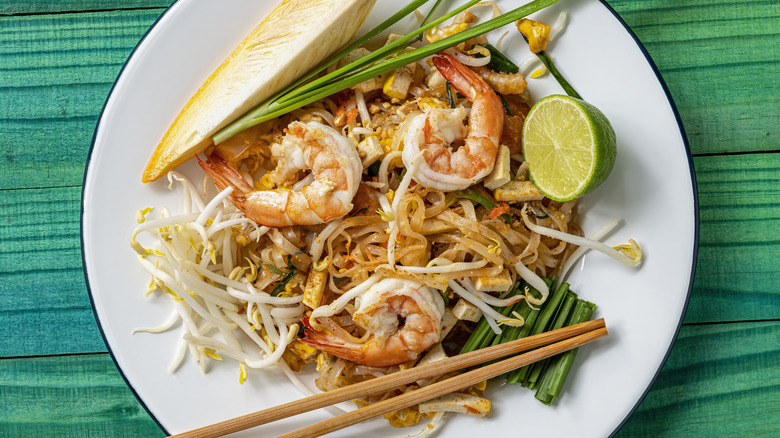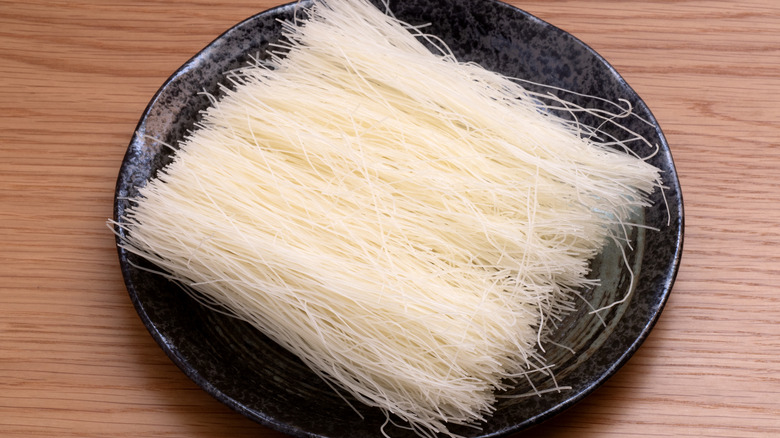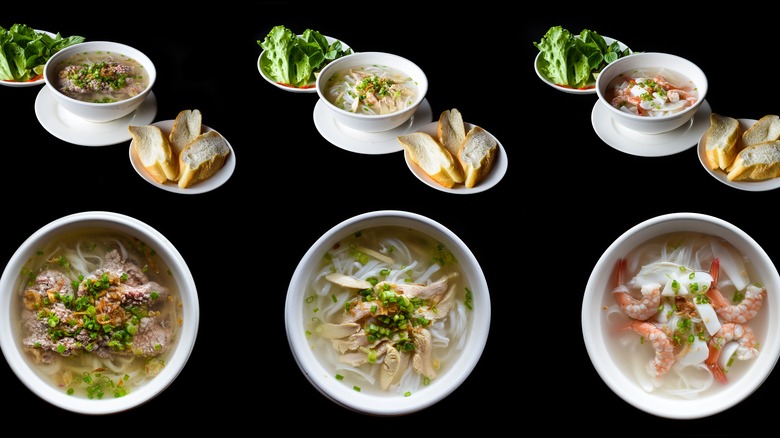For The Absolute Best Rice Noodles, Soak Them First
If you're an enthusiastic cook of noodle-based Asian dishes like pad Thai, chicken pad see ew, or pho, no doubt dried rice noodles are one of your pantry staples. Chances are you've followed the cooking instructions on the package and boiled your rice noodles, often ending up with either a clumpy, undifferentiated mass or plain mush instead of elegant individual strands. Our advice is to pre-cook dried rice noodles by soaking them in room-temperature water, which will not only rehydrate them but eliminate overcooking. The length of the soak, as you might imagine, depends on the size of the noodle — but is typically only as long as an hour and often much less.
The reason that soaking beats boiling has to do with rehydration. Dried rice noodles come in many shapes and sizes, but they all have one thing in common — well, two things: Rice flour and water, which are the main two ingredients. (Rice flour, by the way, is nothing more than ground-up rice.) Both boiling and soaking will rehydrate the noodles, but a rapid boil will quickly overcook them, releasing gelatinized starches and creating lumps and clumps. Moreover, soaking dried noodles not only allows them the time to rehydrate thoroughly (allowing for proper cooking), it rinses starch off their exterior, reducing the risk of clumping.
The bigger the noodle, the longer the soak
The only criterion for the soaking time for dried noodles is size, not their cooking application. So, it doesn't matter if you're making a noodle soup like pho or a stir fry like pad Thai, your rehydrated rice noodles will be ready to go. Buying dried rice noodles is sort of like buying t-shirts, as they come in small, medium, large, and extra-large sizes. For our discussion, we're going to talk about very thin Thai rice vermicelli, small (less than 1/10 inch), and medium-sized noodles (just over 1/10 inch). Vietnamese banh pho noodles range from about 1/16 to ½ inch in width – but generally speaking, thinner noodles are best for soup.
For very thin rice vermicelli, soak between five and 15 minutes, depending on thickness. Small-sized noodles should be soaked for 20 to 30 minutes, and medium-sized for up to an hour. (Remember to use room temperature water.) You'll know your noodles are ready when they go completely limp when picked up, no longer trying to retain their original texture. Alternatively, you can do a taste test, much like spaghetti. The noodles should feel al dente. At this point, they can be drained and used in whatever recipe you're making.
Various dried noodle soaking and cooking contingencies
If you don't have the time to soak dried rice noodles in room-temperature water, you can use hot (but not boiling) water instead. This will reduce the soak times to three minutes for medium-sized noodles and two minutes for small ones. (Don't bother doing this for very thin vermicelli noodles, because their cooking time is negligible.)
If you're stir-frying, toss the drained noodles right in the pan, being careful not to overcrowd it. If you're making a noodle soup with rice vermicelli — and they've been properly soaked through — simply pouring boiling broth over them in the serving bowl should be sufficient enough. If you like soups with a broader noodle, consider blanching them quickly before serving (and we're talking very quickly — not more than five seconds). The most efficient way of doing this is to transfer some of your hot soup broth to a saucepan rather than wait around for the water to boil.


